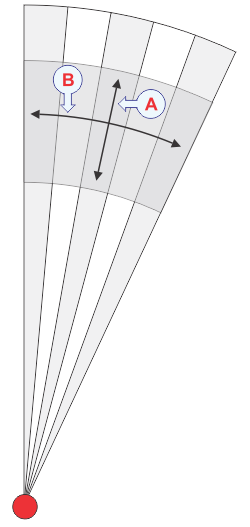Defining the physical size of the tracking area
When you have an echo you wish to track, the tracking functionality places a geographical area around the object. An invisible area - the tracking area - is created as an acquisition area. In order for the ST90 system to find and lock on the intended target, it needs to be kept within this tracking area. If the intended target falls outside the area, the tracking can not be started. Use the Tracking Area Setup dialog box to define or change the physical size of the tracking area.

Illustration:
Each Tracking Area option controls the distance from the inner to the outer radius of the area.
The width of the area is fixed, and stretches across a predefined number of beams. This means that the actual width depends on the distance from your vessel to the area.
The Tracking Area function is used to select the physical size of the area.
You can only define the area size as the distance from the inner to the outer radius of the area. The width of the area is fixed, and stretches across a predefined number of beams.
To track a target efficiently, the area should be as small as possible. For example, use a small area if you track single fish or small schools. However, if the target is large, or moves very fast, a larger area may be beneficial. This may be useful if you track a large school of fish.
Under certain circumstances the target tracking may not follow the intended echo. This may for example happen if the tracking area is too large.
When the size of a tracking area has been changed, the new size will take effect the next time a track is manually initiated.
Procedure
- Open the Setup menu.
- Select Tracking Area on the Setup menu, open the button submenu,
and select Tracking Area Setup.

- Make the necessary adjustments.
- Select OK to save the selected settings and close the dialog box.
Use the Tracking Area Setup dialog box to change the size of the predefined area sizes.
